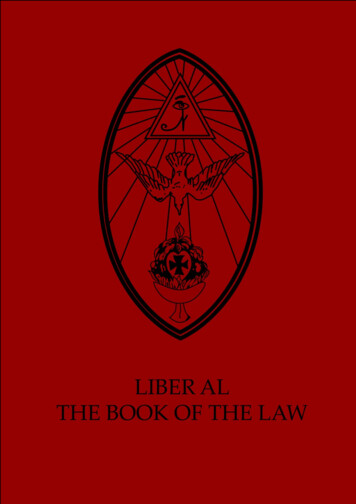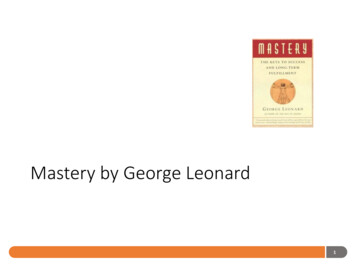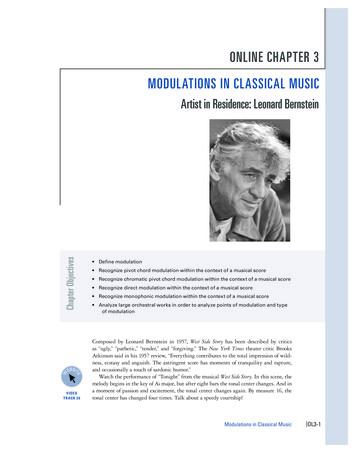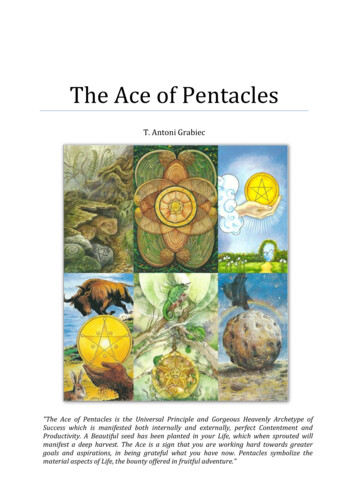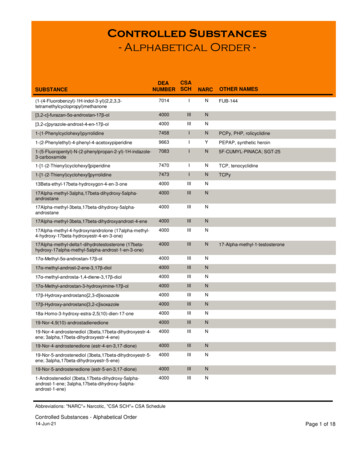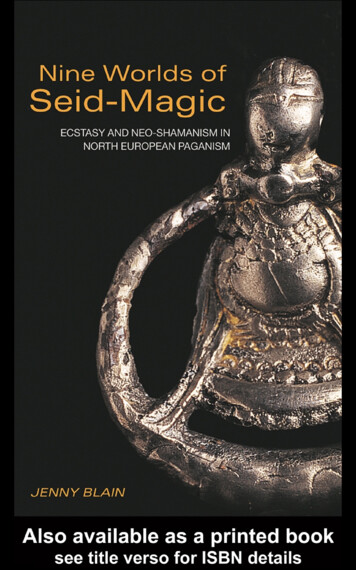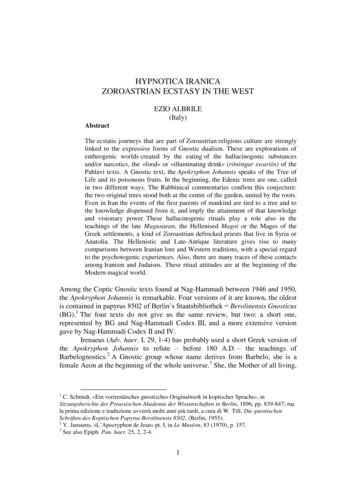
Transcription
HYPNOTICA IRANICAZOROASTRIAN ECSTASY IN THE WESTEZIO ALBRILE(Italy)AbstractThe ecstatic journeys that are part of Zoroastrian religious culture are stronglylinked to the expressive forms of Gnostic dualism. These are explorations ofentheogenic worlds created by the eating of the hallucinogenic substancesand/or narcotics, the «food» or «illuminating drink» (rōnšngar xwarišn) of thePahlavi texts. A Gnostic text, the Apokryphon Johannis speaks of the Tree ofLife and its poisonous fruits. In the beginning, the Edenic trees are one, calledin two different ways. The Rabbinical commentaries confirm this conjecture:the two original trees stood both at the centre of the garden, united by the roots.Even in Iran the events of the first parents of mankind are tied to a tree and tothe knowledge dispensed from it, and imply the attainment of that knowledgeand visionary power. These hallucinogenic rituals play a role also in theteachings of the late Magusaean, the Hellenised Magoi or the Mages of theGreek settlements, a kind of Zoroastrian defrocked priests that live in Syria orAnatolia. The Hellenistic and Late-Antique literature gives rise to manycomparisons between Iranian lore and Western traditions, with a special regardto the psychotogenic experiences. Also, there are many traces of these contactsamong Iranism and Judaism. These ritual attitudes are at the beginning of theModern magical world.Among the Coptic Gnostic texts found at Nag-Hammadi between 1946 and 1950,the Apokryphon Johannis is remarkable. Four versions of it are known, the oldestis contained in papyrus 8502 of Berlin’s Staatsbibliothek Berolinensis Gnosticus(BG).1 The four texts do not give us the same review, but two: a short one,represented by BG and Nag-Hammadi Codex III, and a more extensive versiongave by Nag-Hammadi Codex II and IV.Irenaeus (Adv. haer. I, 29, 1-4) has probably used a short Greek version ofthe Apokryphon Johannis to refute – before 180 A.D. – the teachings ofBarbelognostics.2 A Gnostic group whose name derives from Barbelo, she is afemale Aeon at the beginning of the whole universe.3 She, the Mother of all living,1C. Schmidt, «Ein vorirenäisches gnostisches Originalwerk in koptischer Sprache», inSitzungsberichte der Preussischen Akademie der Wissenschaften in Berlin, 1896, pp. 839-847; mala prima edizione e traduzione avverrà molti anni più tardi, a cura di W. Till, Die gnostischenSchriften des Koptischen Papyrus Berolinensis 8502, (Berlin, 1955).2Y. Janssens, «L’Apocryphon de Jean» pt. I, in Le Muséon, 83 (1970), p. 157.3See also Epiph. Pan. haer. 25, 2, 2-4.1
also has the mission to free the divine element trapped in the material world andstruggling against lower Aeons, to bring light into primordial dwelling.4The Apokryphon Johannis’ plot speaks of a peculiar theogonicdevelopment of the divine principle ( «invisible Spirit»),5 whereby the life forcecontained in the water arouses the luminous manifestation of an androgynousreality ( Barbelo),6 who gives life to the next emanations of the «fullness», theπλήρωμα. The origin of the theogonic process is an epiphany,7 in which the lighthidden in the divine life comes out of its secrecy to reveal itself as a «source ofshining water».8Barbelo, the «image of light», is the first entity to emerge from theSupreme Being, the Heavenly Father unknown and unpredictable. ThroughBarbelo the hypercosmic «son» derives and, later, all the brighting entities9 whichare configured in a πλήρωμα. This light system will break up because of «sisterSophia»10: it is the origin of an irregular generation, the κένωμα, «void», fromwhich rises the Demiurge, the Ruler of the lower world.11 He is an abortivecreation, a sort of monstrous transgender in the resemblance of a dragon with aface of a lion,12 unaware of the existence of πλήρωμα upon him, and proud in hisdeceptive singleness. His name is Ialdabaōth.134Cfr. H. Leisegang, Die Gnosis, Leipzig 1924, pp. 186-196; K. Rudolph, La gnosi. Natura e storiadi una religione tardoantica, ed. it. cur. C. Gianotto (Biblioteca di cultura religiosa, 63), Brescia2000 (ed. or. Göttingen, 1990)3, pp. 132-133; Ch. Markschies, Gnosis. An Introduction, engl.transl. by J. Bowden, (London-New York, 2003), (ed. or. München 2001), pp. 94 ss.5See now M. Waldstein-F. Wisse (eds.), The Apocryphon of John: Synopsis of Nag HammadiCodices II, 1; III, 1; and IV, 1 with BG 8502, 2 (Nag Hammadi and Manichaean Studies 33),(Leiden-Köln, 1995).6Cfr. A.K. Helmbold, «The Apokryphon of John», in Journal of Near Eastern Studies, 25 (1966),p. 268.7C. Colpe, «Heidnische, jüdische und christliche Überlieferung in den Schriften aus NagHammadi V», in Jahrbuch für Antike und Christentum, 19 (1976), pp. 120-129.8BG 26, 19-21.9Apocr. Joh. II, 9, 20; G. Casadio, «Dall’Aion ellenistico agli Eoni-Angeli gnostici», in Avallon,42 (1997), pp. 45-62.10Apocr. Joh BG 36, 16; III, 14, 9.11G. Quispel, The Demiurge in the Apocryphon of John, in R. McL. Wilson (ed.), Nag Hammadiand Gnosis. Papers read at the First International Congress of Coptology (Nag Hammadi Studies,XIV), (Leiden, 1978), pp. 7 ss.12About the lion, cfr. F. Cumont, The Mysteries of Mithra, engl. trans. by T.J. McCormack, (NewYork, 1956) (ed. or. Bruxelles, 1903), pp. 105-110; J. Duchesne-Guillemin, «Aiōn et leléontocéphale, Mithras et Ahriman», in La Nouvelle Clio, 10 (1958-1960), p. 95 ; H.M. Jackson,The Lion Becomes Man. The Gnostic Leontomorphic Creator and the Platonic Tradition (SBLDissertation Series 81), (Atlanta, Georgia, 1985), pp. 1-12 and passim.13Apocr. Joh. II, 24, 12 and passim; for the name, cfr. G.G. Scholem, «Jaldabaoth Reconsidered»,in Aa.Vv., Mélanges d’Histoire des Religions offerts à H.-Ch. Puech, Paris 1974, pp. 410 ss. ; A.Mastrocinque, «Pregare Ialdabaoth», in G. Sfameni Gasparro (cur.), Modi di comunicazione tra ildivino e l’umano. Tradizioni profetiche, divinazione, astrologia e magia nel mondo mediterraneoantico, Atti del II Seminario Internazionale (Hierá 7), (Cosenza, 2005), pp. 203 ss.2
Ialdabaōth, aided by dark powers -- the Archons -- creates the soul ofAdam, a faulty duplicate of an image of light.14 But the psychic man liesmotionless on the ground, devoid of the living breath that the Demiurge and thepowers cannot infuse. Only by a stratagem, the light world will be able to animateAdam.After the creation of the soul, Ialdabaōth and the Archons create the realman, the Adam of flesh; they bring to him the gates of paradise, offering the plantsthat grow there. From the Archons rises a «spirit of imitation»,15 the ἀντίμιμονπνεῡμα that incited Adam towards evil and sin, inviting him to eat from the Treeof Life, the paradise plant with its deadly fruit.16 Its root is bitter, its branches are ashadow of death, its leaves contempt and deceit, its seed drinking itself forever tothe darkness.17Now, the drinking in Gnostic dualism is an action ascribed to the world ofdarkness;18 food and drink nourish the body, antithetical to true life, bright andineffable. Marcion denies the materiality and corporality of Jesus: the Savior feedsand drinks only in appearance (Tert. Adv. Marc. 3, 8, 4).19This suggestion starts from the Synoptics, in a passage that we find, almostidentical, in the first and third Gospel. The subject is John the Baptist of whomJesus says: «John has come, neither eating nor drinking, and they say “He has ademon. The Son of Man has come eating and drinking, and people say: “Here is aglutton and wine drinker (ἰδοὺ ἄνθρωπς φάγος καί οἰνοπότης), a friend ofpublicans and sinners”» (Mt. 11, 18-19). The parallel passage in the Gospel ofLuke (7, 33-34) is the longest, this suggest that it is the oldest20.It is the Gnostic Docetism which also echoes Saturninus (or Satornilo),according to which the Saviour has no body, is a mask that shows itself in humanform (Ir. Adv. Haer. 1, 24, 2).21The Apokryphon Johannis speaks of the Tree of Life and its poisonous22fruits . Those who read the Bible (Gen. 2, 9) learn that among all the lush trees in14R. Van den Broek, «The Creation of Adam’s Psychic Body in the Apocryphon of John», in R.Van den Broek-M.J. Vermaseren (eds.), Studies in Gnosticism and Hellenistic Religions presentedto G. Quispel (EPRO 91), (Leiden, 1981), pp. 38-57.15Janssens, «L’Apocryphon de Jean» pt. III, in Le Muséon, 84 (1971), pp. 414 ss.; cfr. A. Böhlig,«Zum Antimimon Pneuma in den koptisch-gnostischen Texten», in Mysterion und Wahrheit(AGJU, 6), (Leiden, 1968), pp. 162-174 .16G. Filoramo, L’attesa della fine. Storia della gnosi, (Roma-Bari, 1987)2, p. 148.17Apocr. Joh. BG, 56, 4-57, 3 (Synopsis, pp. 124-126); Janssens, «L’Apocryphon de Jean» pt. I, p.159.18See also the Gnostic doctrines of the Mandaeans reflected in Ginz Iamina II, 1 (Petermann,58, 8-18; Lidzbarski, 156).19A. Orbe, «El Hijo del hombre come y bebe (Mt 11, 19; Lc 7, 34)», in Gregorianum, 58 (1977),p. 524.20Orbe, «El Hijo del hombre come y bebe», p. 523.21Ibid. p. 525.3
Eden there were two peculiar ones: «the Tree of Life in the middle of the gardenand the Tree of Knowledge of Good and Evil» (w‘ṣ hḥyym btwk hgn w‘ṣ hd‘t ṭwbwrṣ). God forbids man to eat the fruits of the second tree, the Tree of Knowledge,the Tree of gnōsis.The text, however, falls into contradiction. In fact, Eve, in response to thetempting serpent, says: «Of the fruit of the garden’s trees we may eat, but the fruitof the tree which is in the midst of the garden, God said: “You shall not eat, andyou shall not touch it, otherwise you die”» (Gen. 3, 2-3). Now, in the previouschapter, we read that the tree in the middle of the garden of Eden was not that ofKnowledge, which is forbidden to eat, but the Tree of Life.In the beginning, the Edenic tree is one, called in two different ways. TheRabbinical commentaries confirm this conjecture: the two trees originally stood atthe centre of garden, joined at the roots.23 Other versions describe the Tree ofKnowledge as a hedge enclosing the Tree of Life.24 So, the Apokryphon Johannisseems to derive from an ancient Midrashic tradition older than the drawing up25 ofGenesis.Some Rabbinical sources claim that Adam, by eating the fruit of the Tree,had the gift of prophecy;26 he preferred the gift of knowledge rather thanimmortality. This means that it was an entheogenic fruit, capable of expanding themind over the limits of perception.27Not surprisingly, other sources identify the Tree of Knowledge with a hugeear of corn.28 The cereal, as well as do the origins of agriculture and food, in fact,refers to the hallucinatory ecstasy of ergotism, the Claviceps purpurea poisoning,the sclerotium of rye, the purple mushroom that infests rye and othergraminaceous plants such as wheat, liable in the past and in antiquity of seriousepidemics.29From Claviceps purpurea derives a highly psychoactive compound,LSD. In 1918, the Sandoz laboratories of Basel, isolated and purified the firstergot alkaloid. In 1934 it was possible to recognize the lysergic acid as a commonbasis of all derivatives of ergot. But the breakthrough came in 1943 when AlbertHofmann, in charge of studying the lysergic acid amides at the Sandoz22I.S. Gilhus, «The Tree of Life and the Tree of Death», in Religion, 17 (1987), pp. 337-353.L. Ginzberg, The Legends of the Jews, V, (Philadelphia, 1925), p. 91 n. 51.24Ginzberg, The Legends of the Jews, I, (Philadelphia, 1909), p. 70; V, p. 91 (trad. it. di E.Loewenthal, Le leggende degli ebrei, I [Biblioteca Adelphi 314], (Milano, 1995), p. 79).25Cfr. G. Garbini, «Tra Egitto e Babilonia», in Storia e ideologia nell’Israele antico (Biblioteca distoria e storiografia dei tempi biblici, 3), (Brescia, 1986), pp. 183-207.26Gen. Rab. 200-201; Yalqut Gen. 34; Ginzberg, The Legends of the Jews, V, pp. 97-98; R.Graves-R. Patai, I miti ebraici («Il Cammeo», 4), (Milano, 1980), p. 94.27Graves-Patai, I miti ebraici, pp. 98-99, n. 10.28Gen. Rab. pp. 139-142.29Ch. Rätsch, Enzyklopädie der psychoaktiven Pflanzen. Botanik, Ethnopharmakologie undAnwendung, AT Verlag, (Aarau (Schweiz), 2007)8, pp. 645 a-650 c.234
laboratories,30 accidentally came in contact with one of them (the twenty-fifthdiethylamide of d-lysergic acid). After a few hours he was hit by phenomena ofalterate perception. Albert Hofmann began the studies on the modified states ofconsciousness induced by this substance. One quarter of a milligram of LSD wasenough to provoke a radical revulsion of ordinary perception. This surprisingdiscovery was confirmed in 1962 by W.A. Taber and in 1964 by K. Genest.The ecstatic journeys are part of Zoroastrian religious culture,31 stronglylinked with the expressive forms of Gnostic dualism.32 Explorations of worldsproduced by entheogenic drugs and/or narcotics, the «food» or «illuminatingdrink» (rōnšngar xwarišn) of the Pahlavi texts.33 The Avestan word baŋha- ( Pahlavi bang/mang) linked with the Sanskrit bhangā, «hemp», the κάνναβς ofHerodotus (4, 74, 1), is of great interest under this point of view.34The Frawardīn Yašt speaks of a liturgy celebrated with much baŋha(pouru.banŋhahe zaošahe ašaonō fravašim yazamaide: Yašt 13, 124 a), 35 while,in contrast, the Widēwdād seems to restrict or stigmatize its ecstatic use.36 Thebang or mang is sometimes called «medicine» (Avestan baēšazya- Pahlavibēšaz)37 and has – according to the doses, use, and where the plants are identified– sedative, analgesic, hallucinogenic and/or anesthetic properties.38 The action ofthis compound should be considered together with the Avestan haoma- ( pahlavihōm) the psychoactive plant related with the Vedic soma-. The haoma is the mainsubject of the Avestan sacrifice, the entheogenic fluid receptacle of light force,39the libation at the heart of Zoroastrian religion cult.4030Cfr. A. Hofmann, LSD il mio bambino difficile, trad. it. R. Fedeli, (Milano, 2005) (ed. or.Stuttgart 1979), pp. 49 ss.31Ph. Gignoux, «La signification du voyage extra-terrestre dans l’eschatologie mazdéenne» inAa.Vv., Mélanges d’Histoire des Religions offerts à H.-Ch. Puech, pp. 67 ss.32See G. Widengren, «Les origines du
Adam, a faulty duplicate of an image of light.14 But the psychic man lies motionless on the ground, devoid of the living breath that the Demiurge and the powers cannot infuse. Only by a stratagem, the light world will be able to animate Adam. After the creation of
